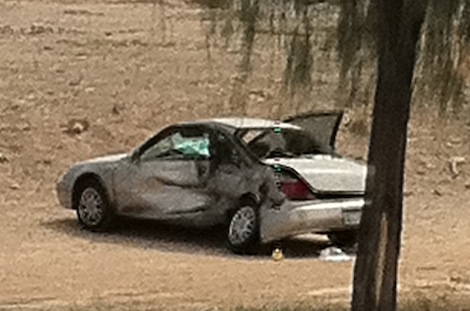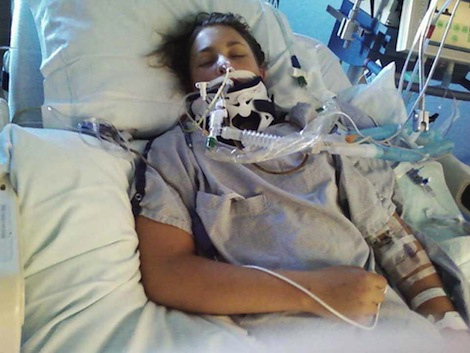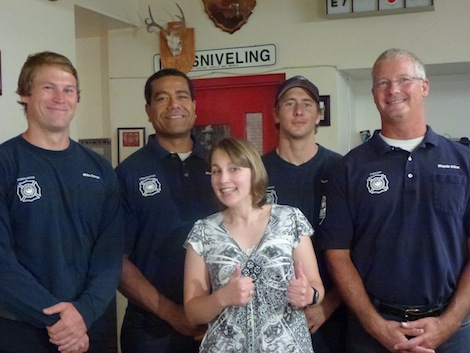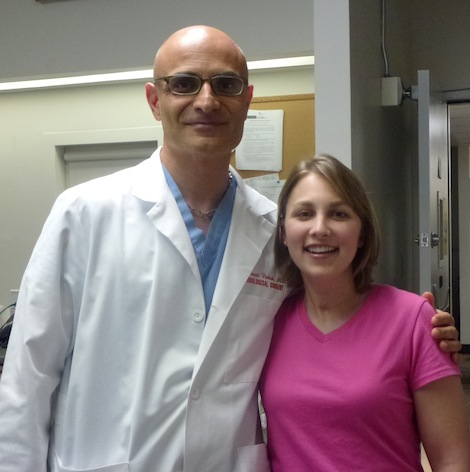Rachel Bailey is someone who believes in giving. She’s someone who volunteers her time for causes that do good for those in need. She never imagined that someday, she would be the one whose life would depend on receiving the gift.
Rachel with the firefighters and paramedics from Phoenix Fire Department Station 7 who kept her alive and stabilized after a nearly-fatal car accident.
In September of 2011, Rachel was driving to work on a typically clear, sunny day in Phoenix. As she turned from a side street onto Cave Creek Road, she was hit broadside by a mid-sized pickup truck going an estimated 50 miles an hour. The truck smashed violently into her driver’s side door causing her to be internally decapitated – her skull actually was severed from her spine. Miraculously, Bailey has not only cheated death, but was saved from permanent paralysis as well.

The force of the crash knocked Rachel’s car completely off the road.
According to Gianni Vishteh, MD, a trauma neurosurgeon at John C. Lincoln North Mountain Hospital, internal decapitation injuries are almost always fatal. Those few who do survive are usually paralyzed.
Dr. Vishteh says. “When such injuries occur, the head is only supported via soft tissue and skin. Movement one way or the other can lead to catastrophic spinal cord injury.”
At any point after the impact, the slightest wrong move – something as simple as a cough – could have resulted in permanent damage to Rachel’s spinal cord. Rachel’s father, David Bailey, admits he has “no idea at all” how it is that the injury was not more damaging than it was.
“After the truck hit her,” he says, “her car crossed the street and bounced up over a curb. After the front wheels bumped up over the curb, the back wheels went over as well. That alone seems to me would be enough to give you whiplash.”
A man working at an auto body shop near the scene of the accident ran across the street to Rachel’s car, finding her unconscious. He, himself, had been in a very serious accident at one time and knew the importance of keeping her head still. Despite the fact that there was some smoke in the car, he did not try to get her out of the vehicle but rather held her head against the headrest until paramedics arrived.
Emergency personnel from Phoenix Fire Station 7, on East Hatcher, arrived on the scene less than 10 minutes after the accident occurred. Rachel was immediately transferred to the Level I Trauma Center at John C. Lincoln North Mountain Hospital where, ironically, Rachel had previously done volunteer work.
In fact, her mother, Gail Bailey, had worked at John C. Lincoln North Mountain Hospital many years previously, and one of her children was born there.
“I had a love for that hospital to begin with,” Gail says. “Since Rachel’s accident, we’ve gone back to visit the ICU there fairly often, and Rachel was introduced to Dr. Vishteh and the nurses and doctors who cared for her. It’s uncanny really, since she was not conscious while she was there, but she feels very comfortable and at home there. And they get to see the fruit of their labor, if you will.”

Rachel spent weeks in John C. Lincoln’s Intensive Care Unit.
That labor saved the young woman’s life – and gave her the chance to have that life be a healthy, productive and normal one. It was far from a foregone conclusion. When Dr. Vishteh was consulted to see Rachel, she had suffered both a very bad head injury and a very bad spinal injury. She was comatose, and she was paralyzed in her left leg and arm.
As Dr. Vishteh recalls, “We placed a brain pressure monitor, and once her brain pressures were low and under control, we proceeded with management of her neck injury. During this period, Rachel’s neck was kept immobilized.”
The spinal injury itself was a very complicated type of occipital cervical dissociation, involving dislocation of the first vertebra off the second vertebra in Rachel’s neck. She had also torn some very important ligaments, including the transverse ligament and the C1-C2 interspinous ligaments that would usually hold her skull together with her upper spine.
“Rachel’s treatment was custom made to address her specific injury,” Vishteh says. “We placed screws in the first and second vertebrae, and used rods and wires to further reduce and fixate the dislocation.” Rachel’s own hip bone was used to promote fusion and healing.
Dr. Vishteh continues, “It would have been possible to use a procedure known as occipital cervical fusion, where you fuse the entirety of the head to the neck. But, given her young age and the specific subtype of injury, I thought it would be worth an attempt to fixate the first two cervical vertebrae, rather than doing an occipital cervical fusion that would have much more severely restricted her neck’s range of motion in the long run.”
The accident wiped out approximately six weeks of memory surrounding the crash. Rachel doesn’t remember anything from about two or three days prior to the crash, to about five weeks after.
“For four weeks I was in a coma,” she says. “The first thing I remember after the accident was waking up in the hospital. My mom had to tell me several times what had happened to me. I just remember being held in such peace. I just knew that everything was going to be okay, that everything was going to work out.”
Because of her tracheotomy, Rachel says, “I couldn’t speak at all for the next two weeks. I had to write on a white board to get my thoughts across. I wrote to my mom, “It was no accident. Have faith. God knows.” Throughout her recovery, whenever she’s gotten down or discouraged, her faith has been a major factor in helping her stay grounded and moving forward.
“I just believe this is all part of God’s plan for me,” she says.
Rachel and Dr. Vishteh share a moment during taping for the NBC Today show
When she was transferred from North Mountain Hospital to a long-term acute care facility a month later, she still had not regained consciousness. She was in hospitals for about two months before finally being able to come home. Then, the very next day, she began intensive rehabilitative therapy, often for hours a day,
“I’ve had to re-train my body how to move normally again,” she explains. “I am in a special program now that lasts eight hours a day, Monday through Thursday, that’s a lot of cognitive retraining. I’ve got physical therapists, speech therapists, occupational therapists, a neuropsychologist, a psychiatrist, just an unbelievable amount of people.”
Dr. Vishteh points out that survival of an injury such as Rachel’s can be often largely a matter of luck. He also observes, however, that her excellent physical condition probably played a role. Rachel worked as a personal trainer and kept herself in good shape through workouts and an overall healthy lifestyle. She also credits her muscular strength as a factor in her survival and recovery.
“There were some dark days and nights,” Dr. Vishteh says, “when it was touch and go. But she’s a fighter and a very inspirational person.”
Although Rachel’s nearly full recovery is something rare, it’s not unheard of. Dr. Vishteh and the trauma staff at John C. Lincoln North Mountain Hospital have had a number of other such successful cases.
“We have to give credit to our excellent EMT services who made really good decisions about how to handle Rachel right at the scene of the crash,” Dr. Vishteh continues. “Also, there have been such advances in diagnostics, CAT scans and MRIs and the like.”
What makes Rachel’s case unique, as far as Dr. Vishteh is concerned, is the young woman herself. That’s most readily evident in the way that she is giving back.
“I volunteer at John C. Lincoln North Mountain Hospital in Patient Hospitality, and I also volunteer with the Trauma Survivors Support Network,” she says. Approximately once a week, along with her mother, Rachel goes to the ICU or other floors at the hospital and meets with people going through some of what she went through, giving the gift of encouragement.
As to the medical personnel who saved her life at John C. Lincoln and those at the other facilities who have cared for her throughout her recovery, she says, “I just thank them from the very bottom of my heart for taking care of me. They’re amazing. I couldn’t have asked for a greater staff caring for me. I was at the right place at the right time. From Dr. Vishteh doing my neck surgery, to the nurses and ICU staff, they are all just very skillful and compassionate.”
Just as her medical team gave to her, she’s determined to continue giving back.
“To live is to give,” she says. It’s hard to put it any better than that.
To learn more about John C. Lincoln Hospital and their doctors, visit www.jcl.com

The NBC Today show flew Rachel and her parents to New York City, where Jenna Wolfe interviewed her about her miraculous survival for their nationwide morning broadcast.

